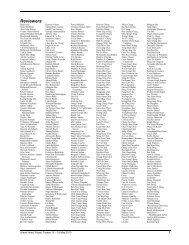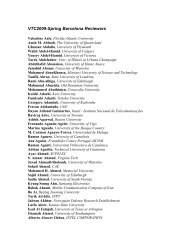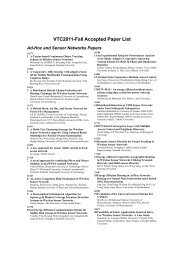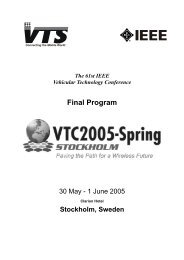Final Programme 2 â 5 June 2013 Dresden, Germany - ieeevtc.org
Final Programme 2 â 5 June 2013 Dresden, Germany - ieeevtc.org
Final Programme 2 â 5 June 2013 Dresden, Germany - ieeevtc.org
You also want an ePaper? Increase the reach of your titles
YUMPU automatically turns print PDFs into web optimized ePapers that Google loves.
Since then he has joined Instituto de Telecomunicações,<br />
working as a senior researcher in 4Tell Group. He was with<br />
Ericsson Research Labs in 2005, working as a research<br />
engineer. His research interests include green<br />
communications, cognitive radio, cooperative networking,<br />
radio resource management, cross-layer design, heterogeneous<br />
networks, M2M and D2D communication, and baseband<br />
digital signal processing. He has more than 30 publications in<br />
international conferences, journal papers and book chapters.<br />
He co-authored/co-edited one book for River publisher. He is a<br />
guest editor for one special issue in IEEE Wireless Comms<br />
Magazine. (https://sites.google.com/site/shahidmumtaz2012/)<br />
Jonathan Rodriguez received his Masters degree in<br />
Electronic and Electrical Engineering and Ph.D from the<br />
University of Surrey (UK), in 1998 and 2004 respectively. In<br />
2002, he became a Research Fellow at the Centre for<br />
Communication Systems Research and was responsible for<br />
coordinating Surrey involvement in European research<br />
projects under framework 5 and 6. Since 2005, he is a Senior<br />
Researcher at the Instituto de Telecomunicações (Portugal),<br />
and founded the 4TELL Wireless Communication Research<br />
Group in 2008. The 4TELL group currently constitutes 30<br />
researchers with a project portfolio that includes 10 ongoing<br />
European collaborative research projects. He is currently the<br />
project coordinator for the seventh framework C2POWER<br />
project, and technical manager for COGEU; and project<br />
coordinator for CELTIC GREEN-T. He is author of more than<br />
160 scientific publications, served as general chair for several<br />
prestigious conferences and workshops, and has carried out<br />
consultancy for major manufacturers participating in DVB-T/H<br />
and HS-UPA standardization. His research interests include<br />
green communications, cognitive radio, cooperative<br />
networking, radio resource management, cross-layer design<br />
and baseband digital signal processing<br />
Dr Jonathan Rodriguez presents different tutorial on system<br />
level simulator and green technology in wireless<br />
communication in different conferences while Dr Shahid<br />
Mumtaz has a distinguished and long research background.<br />
2 <strong>June</strong> <strong>2013</strong>,13:30–17:00 Seminar 5<br />
T6: Small Cells Technologies in LTE Advance<br />
and Beyond<br />
Li-Chun Wang, National Chiao Tung University; Chiung-Jang<br />
Chen, Chunghwa Telecom Laboratories<br />
In this tutorial, we discuss the performance issues of<br />
heterogeneous networks (HetNet) utilizing a mix of macrocells,<br />
remote radio heads (RRH) and low-power nodes such as<br />
picocells, femto-cells, and relay. From both theoretical and<br />
practical operator's perspectives, we investigate how to<br />
optimize the wireless networks with underlay small cells. We<br />
begin with an update of 3GPP LTE Advanced followed by an<br />
overview of various deployments scenarios of small cells<br />
considered in the 3GPP standardization. Then we discuss<br />
interference mitigation techniques in small cells and HetNet.<br />
Last, we highlight the potential research issues in radio and<br />
access technologies of 5G wireless to conclude this tutorial.<br />
Li-Chun Wang (M96 SM06 F11) received the B.S. degree from<br />
National Chiao Tung University, Taiwan, R. O. C. in 1986, the<br />
M.S. degree from National Taiwan University in 1988, and the<br />
Ms. Sci. and Ph. D. degrees from the Ge<strong>org</strong>ia Institute of<br />
Technology , Atlanta, in 1995, and 1996, respectively, all in<br />
electrical engineering. From 1990 to 1992, he was with the<br />
Telecommunications Laboratories of the Ministry of<br />
Transportations and Communications in Taiwan (currently the<br />
Telecom Labs of Chunghwa Telecom Co.). In 1995, he was<br />
affiliated with Bell Northern Research of Northern Telecom,<br />
Inc., Richardson, TX. From 1996 to 2000, he was with AT&T<br />
Laboratories, where he was a Senior Technical Staff Member<br />
in the Wireless Communications Research Department. In<br />
August 2000, he joined National Chiao Tung University in<br />
Taiwan, and is currently the Chairman of the Department of<br />
Electrical Engineering of NCTU since Aug. 2012. His current<br />
research interests are in the areas of radio resource<br />
management and cross- layer optimization techniques for<br />
wireless systems, heterogeneous wireless network design, and<br />
cloud computing for mobile applications. He was elected to the<br />
IEEE Fellow grade in 2011 for his contributions in cellular<br />
architectures and radio resource management in wireless networks.<br />
Dr. Wang was a co-recipient (with Gordon L. Stüber<br />
and Chin-Tau Lea) ofthe 1997 IEEE Jack Neubauer Best<br />
Paper Award for his paper Architecture Design, Frequency<br />
Planning, and Performance Analysis for a Microcell/Macrocell<br />
Overlaying System, IEEE Transactions on Vehicular<br />
Technology, vol. 46, no. 4, pp. 836-848, 1997. He has<br />
published over 180 journal and international conference<br />
papers. He served as an Associate Editor for the IEEE Trans.<br />
on Wireless Communications from 2001 to 2005, the Guest<br />
Editor of Special Issue on Mobile Computing and Networking<br />
for IEEE Journal on Selected Areas in Communications in<br />
2005 and on Radio Resource Management and Protocol<br />
Engineering in Future IEEE Broadband Networks for IEEE<br />
Wireless Communications Magazine in 2006. He is holding<br />
nine US patents.<br />
Dr. Chiung-Jang Chen received his Ph.D. degree in<br />
communication engineering from National Chiao Tung<br />
University, Taiwan, in 2005. Since 1995 he was with<br />
Chunghwa Telecom Laboratories, Taiwan, and now is the<br />
project manager of LTE-A/B4G project in the wireless<br />
communications research department.<br />
2 <strong>June</strong> <strong>2013</strong>,13:30–17:00 Seminar 6<br />
T8: V2V Safety Communications: An overview<br />
and examination of technical challenges<br />
John B. Kenney, Toyota InfoTechnology Center, USA; Gaurav<br />
Bansal, Toyota InfoTechnology Center, USA<br />
In this tutorial we cover the most important aspects of<br />
Dedicated Short Range Communications (DSRC), also known<br />
as Cooperative ITS. This technology is currently being<br />
considered for deployment in North America, Europe, and<br />
other parts of the world. DSRC is used to communicate<br />
vehicle-to-vehicle (V2V) and vehicle-to/from-infrastructure<br />
(V2I), enabling a set of compelling applications for safety,<br />
mobility, commerce, and environmental improvement. This<br />
tutorial focuses on the safety use case. The tutorial material<br />
includes the various layers of the protocol stack, V2V & V2I<br />
collision avoidance applications, and the technical challenges<br />
that are being addressed on the path to deployment. We will<br />
talk about government-sponsored field tests, like the US DOT<br />
Safety Pilot and the European DRIVE C2X, which are moving<br />
the technology out of the lab and into realistic vehicular<br />
environments. After presenting the basics of DSRC, we focus<br />
on one specific research problem that is currently of great<br />
interest: DSRC Channel Congestion. We discuss the merits of<br />
various approaches to address congestion, including avoidance<br />
and active control, as well as targets for control (message rate,<br />
transmit power, bit rate, and advanced techniques like carrier<br />
sense control). <strong>Final</strong>ly, as a case study we will discuss our<br />
specific research on adaptive message rate control. The primary<br />
goal of the tutorial is to empower the attendee to participate in<br />
this important emerging technology, whether as a researcher, a<br />
developer, or a planner.<br />
Dr. John B. Kenney: John holds electrical engineering degrees<br />
from Stanford and Notre Dame, where he also served as<br />
28 The 77th IEEE Vehicular Technology Conference VTC<strong>2013</strong>-Spring <strong>Dresden</strong> <strong>Programme</strong>







